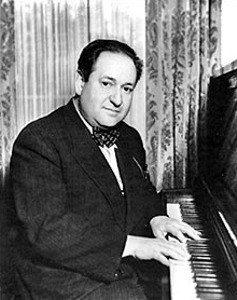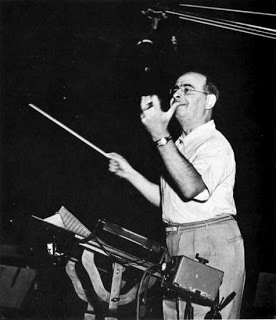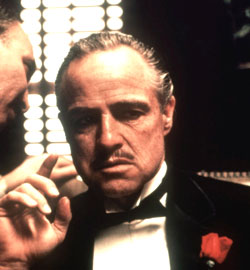The term leitmotif was first applied to the operas of Richard Wagner to describe a recurring melody that is associated with a certain character, people, object, place, emotion, or idea. The leitmotif has long been a standard technique of how film music is used and was especially popular in the era of classical Hollywood films in the 1930s and 40s with composers like Erich Korngold and Max Steiner. So what qualifies as a leitmotif in film? In Music and Cinema, music scholar Justin London writes that a leitmotif generally has three features: it is short, distinctive, and consistent.


Feature 1: Short Length
To say that a leitmotif is short does not mean that it can’t start out as, or be developed into, something longer. Indeed, many of the leitmotifs of classical Hollywood are true “themes” of more than a bar or two of music. But all that is needed to identify the leitmotif is the opening one or two bars. Think of the Indiana Jones theme. Sure, the theme is given a full-blown presentation as the “Raiders March”, but usually all we hear are the first few notes of its melody, and that’s enough for us to recognize the leitmotif.
Feature 2: Distinctiveness
Because we are expected to remember it when it comes back, a leitmotif is always made distinctive in some way. This is usually done by setting a melodic string of notes to a certain rhythm, but the accompanying harmony is important as well because it gives us the emotional quality of the leitmotif. In Darth Vader’s theme, the chord progression in the first couple of bars moves between two chords in a minor key, I and minor VI. Because in a minor key VI is a major chord, its appearance as a minor chord here creates a darker sound appropriate to the “evil” quality of Vader and the Empire.
Feature 3: Consistency
A leitmotif is always consistent in its presentation in order for it to remain recognizable with each statement. This is not to say that leitmotifs are always played in exactly the same way, because they certainly aren’t! Even when their orchestration, harmony, and accompaniment style are drastically changed, leitmotifs still remain identifiable because of their consistent melody and rhythm. In Ennio Morricone’s score for Once Upon a Time in the West, for example, the villain Frank is introduced with a threatening melody in the electric guitar. But near the end of the film, this same theme is heard in a low trumpet with a funeral march accompaniment, indicating Frank’s imminent death. Hear (and see) the difference for yourself. The first version occurs at 0:40 in this scene:
and the second version occurs at the start of this scene:
Functions of Leitmotifs
One powerful function of leitmotifs is to indicate someone or something that is present in the scene but not visible in the frame. The most familiar example is the famous two-note leitmotif for the shark in Jaws, whose presence is often only implied by the music. Even less literally, a leitmotif will sometimes be played to suggest a character, place, etc. that is not physically present in the scene but is being thought about or somehow has an impact on the current scene. In The Godfather, for example, in the famous scene in which a movie producer wakes up to a find severed horse’s head in his bed, we hear leitmotifs associated with the Godfather, clarifying that the deed was done at the Godfather’s request.
 As suggested above, one other important function that leitmotifs have is to express the emotional quality of the thing to which it refers. Obvious examples are the romantic sound of melodies in the high strings, or the heroic sound of themes in the trumpets. But there are many examples of unusual music used as leitmotifs. In Stanley Kubrick’s 2001: A Space Odyssey, almost every appearance of the monolith is associated with the “Kyrie” from György Ligeti’s Requiem. The fact that this music avoids recognizable chords, melodies, and rhythms makes it emotionally quite unsettling. And this unsetting effect is an ideal fit with the monolith, which abstractly seems to represent that which we do not understand. And that which we do not now understand, Kubrick seems to be saying, strikes fear in the hearts of us all.
As suggested above, one other important function that leitmotifs have is to express the emotional quality of the thing to which it refers. Obvious examples are the romantic sound of melodies in the high strings, or the heroic sound of themes in the trumpets. But there are many examples of unusual music used as leitmotifs. In Stanley Kubrick’s 2001: A Space Odyssey, almost every appearance of the monolith is associated with the “Kyrie” from György Ligeti’s Requiem. The fact that this music avoids recognizable chords, melodies, and rhythms makes it emotionally quite unsettling. And this unsetting effect is an ideal fit with the monolith, which abstractly seems to represent that which we do not understand. And that which we do not now understand, Kubrick seems to be saying, strikes fear in the hearts of us all.
In fact, since the resurgence in popularity of the leitmotif in the 1970s with films like Star Wars, composers have often sought out unusual sounds to act as leitmotifs. In The Dark Knight (2008), Hans Zimmer’s leitmotif for the Joker is a buzzy metallic sound composed of two tones—one that stays the same and another that gradually slides up, producing an eerie sound that suggests the twisted mind of the character. Have a listen to it here:
Clearly, the leitmotif has served films well, both for its denotation of a character, place, etc., and for its emotional connotation. Considering that movies are all about relating characters and places to us in an emotional way, it is no wonder the technique continues to be such an important one.
Pingback: Special Subject Investigation | Astrid Hudson
Pingback: Digital Media Technologies Week 4 Class 3 – RMIT Student 3599525
A very good example of heavy leitmotif use would be the “Once Upon A Time” show. There are several romantic connections that form throughout the series that have their own leitmotif associated with them; for example, every time Snow White and Prince Charming have a moment together, or Belle and Rumplestiltskin have a moment together, their individual “theme” plays somewhere in the background. It is HIGHLY effective in establishing emotional connotation of each romance.